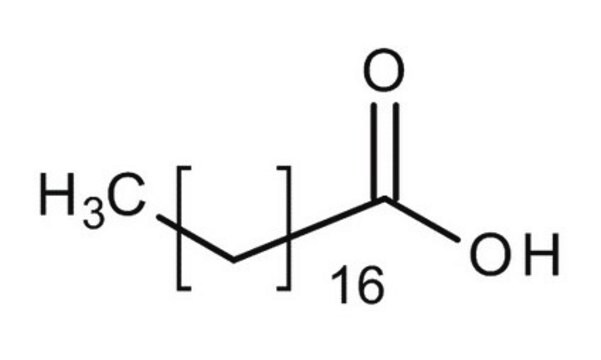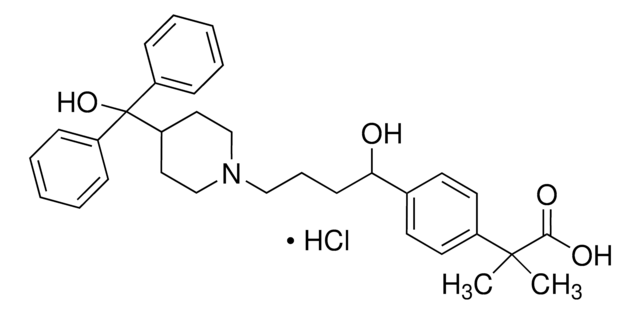1621008
USP
Acide stéarique
United States Pharmacopeia (USP) Reference Standard
Synonyme(s) :
1-Heptadecanecarboxylic acid, C18:0, Cetylacetic acid, NSC 25956, NSC 261168, Octadecanoic acid, Stearophanic acid
About This Item
Produits recommandés
Qualité
pharmaceutical primary standard
Pression de vapeur
1 mmHg ( 173.7 °C)
Famille d'API
stearic acid
Fabricant/nom de marque
USP
pb
361 °C (lit.)
Pf
67-72 °C (lit.)
Solubilité
acetone: soluble
benzene: freely soluble
chloroform: freely soluble
ethanol: soluble
ether: freely soluble
propylene glycol: soluble
water: practically insoluble
Densité
0.845 g/cm3
Application(s)
pharmaceutical (small molecule)
Format
neat
Chaîne SMILES
CCCCCCCCCCCCCCCCCC(O)=O
InChI
1S/C18H36O2/c1-2-3-4-5-6-7-8-9-10-11-12-13-14-15-16-17-18(19)20/h2-17H2,1H3,(H,19,20)
Clé InChI
QIQXTHQIDYTFRH-UHFFFAOYSA-N
Vous recherchez des produits similaires ? Visite Guide de comparaison des produits
Description générale
Application
- Palmitic Acid
- Calcium Stearate
- Sodium Stearate
- Aluminum Monostearate
- Glycerin Suppositories
- Magnesium Stearate
Remarque sur l'analyse
Autres remarques
Produit(s) apparenté(s)
Code de la classe de stockage
11 - Combustible Solids
Classe de danger pour l'eau (WGK)
nwg
Point d'éclair (°F)
Not applicable
Point d'éclair (°C)
Not applicable
Faites votre choix parmi les versions les plus récentes :
Certificats d'analyse (COA)
Désolés, nous n'avons pas de COA pour ce produit disponible en ligne pour le moment.
Si vous avez besoin d'assistance, veuillez contacter Service Clients
Déjà en possession de ce produit ?
Retrouvez la documentation relative aux produits que vous avez récemment achetés dans la Bibliothèque de documents.
Les clients ont également consulté
Notre équipe de scientifiques dispose d'une expérience dans tous les secteurs de la recherche, notamment en sciences de la vie, science des matériaux, synthèse chimique, chromatographie, analyse et dans de nombreux autres domaines..
Contacter notre Service technique






